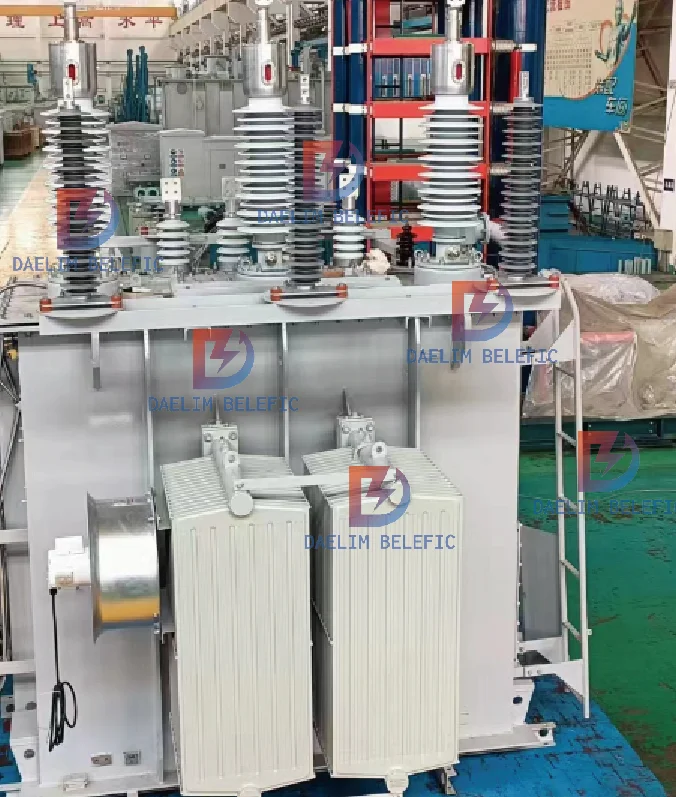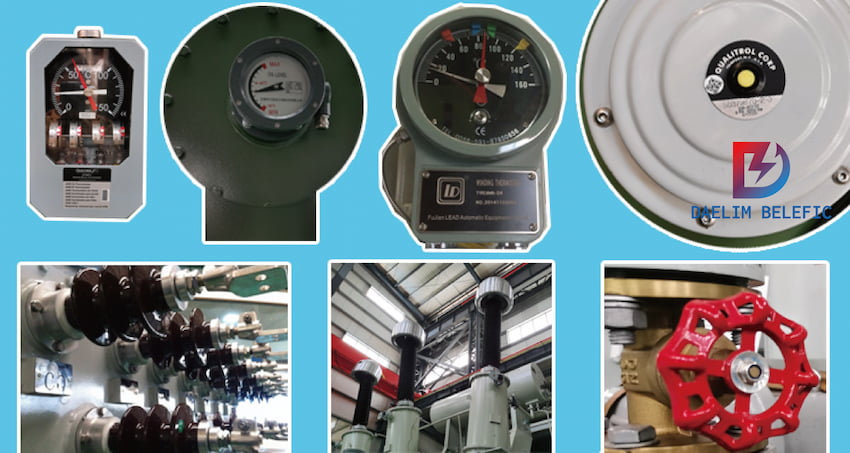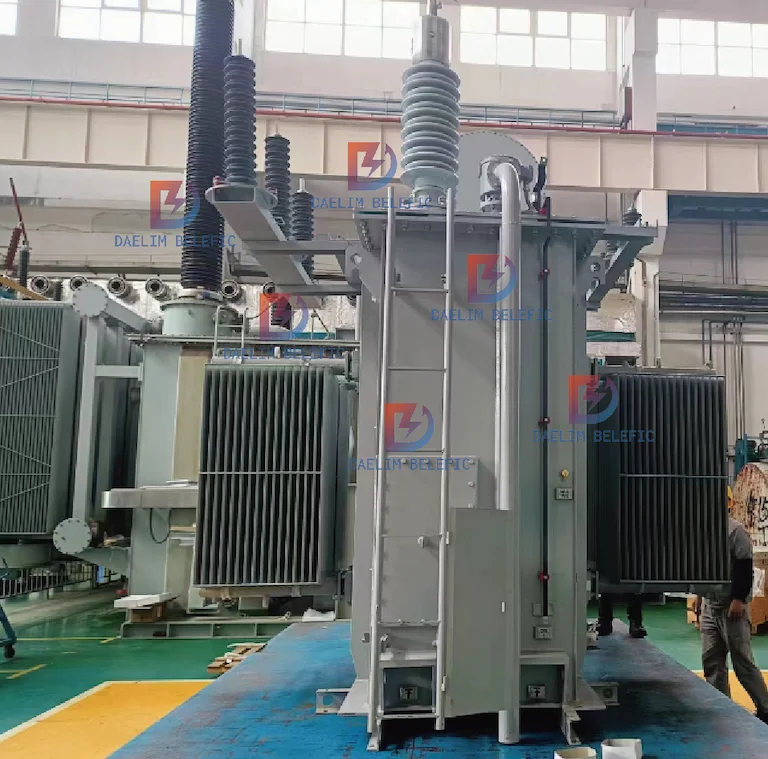
How to Choose Pad Mounted Transformer?
Table of Contents Selecting the right pad-mounted transformer requires careful consideration of several critical
ELECTRIC, WITH AN EDGE
Power Transformer have been around for more than a century and as time continues to move forward, so does the advancement of transformers. In fact, the use of transformers continues to increase as the world’s population grows.
Power transformers are a type of transformer that is currently in high demand all over the world because of their many useful functions and attributes, like supplying electricity to multiple houses, regulating voltages, etc.
In this article, one of the greatest transformer manufacturers in China – DAELIM, will provide you with all the necessary information you need to completely understand what power transformers are.
But first, you should know what transformers are in general.
Transformers come in various sizes and shapes. There are transformers that are big as cars, and transformers that are the size of a barrel. Cooling mediums for transformers are different too.
Some transformers use pressurized air or forced air as a natural way of cooling or regulating the transformer’s temperature. Other transformers use oil as an effective way to keep temperature at moderate levels.
But regardless of the shape, size, and cooling medium, all transformers have one thing in common and that is to regulate voltages, current, or electricity in general.
Nevertheless, they are certainly not limited to that function. Transformers are used in many ways. An example of this is that it can be used to reduce voltage of conventional power circuits to operate low-voltage appliances or devices.
It can be for simple doorbells, electric stoves, microwaves, etc.
Transformers can be used to raise voltages as well from electric generators to transmit electrical power over long distances.

Transformers help and improve safety and efficiency of power systems stepping up (increasing) or stepping down (decreasing) voltages when needed. Transformers are used for both urban and rural areas. One of its important assets is the proper distribution and regulation of electrical power over long distances.
Most transformers work on the principle of mutual induction. Mutual induction is an occurrence that happens when the amount of magnetic flux linked with a coil charges an electromotive force that is induced in the nearest coil.
Most transformers are made up of a rectangular iron core.
Mutual induction refers to the ability of an inductor in one circuit to induce a voltage in or to another circuit. When a transformer has alternating currents flowing in its conductor, magnetic flux will surround the conductor in proportion to the amount of the current.
Magnetic flux is the measurement of the total magnetic field that passes through a certain or given area. This helps a lot because it describes the effects of the magnetic force on something that is occupying the given area.
The measurement of magnetic flux is associated with the certain area chosen.
A magnetic field in transformers is considered a medium or vector field that describes the magnetic influence on flowing electricity including electric currents, electric charges, and as well as magnetic materials. Moving charges in a magnetic field will encounter a force that is perpendicular to its velocity and magnetic field.
Now that you know what a transformer is in a bigger picture, understanding power transformers will be much easier. But if there is something that you do not quite comprehend or if there is something you want to clarify after you have read everything, do not hesitate to contact DAELIM’s team of professionals for assistance.
So, what is a power transformer? To begin with, power transformers are electrical instruments that are employed to transmit power from circuit to circuit within the electromagnetic induction.
The power transfer smoothly runs without any frequency variation. In an electronic network, the power transformer’s state is applied to present a number of AC supplies of multiple voltages and compatible values of current from the public electricity support system.
It is also employed to represent the power transformers within the range of 500 kVA (kilovolt-ampere) or more.
As aforementioned, transformers are used to transmit electricity to a certain component of the electrical circuit in the range of distribution circuits and the generator that it is linked to. Power transformers are capable of doing this process, which is why power transformers are commonly utilized in distribution networks as well to adjust voltage levels.
To understand it better, here is another definition with simpler terms: power transformers convert electricity regardless if it is high or low voltage for various purposes.
In power grids, it is considered to be a major component to supply voltage to the lines that are connected. Its destination is to supply voltages to the connect lines that are connected to the power transformer.
This is why power transformers are somewhat similar to distribution transformers but it has its unique characteristics and attributes. When it comes to applications, power transformers are commonly used for transforming power from circuit to circuit without the change or disruption of frequency.
This is the basic definition of most transformers that is applicable to power transformers.Another thing that is worth mentioning is that there are no moving parts in power transformers. So, they are considered as static devices.
Power transformers only operate on an AC supply, but this does not mean that it does not work on multiple principles.
They can also be used for regulating transmission networks that are at high voltages, both stepping up and stepping down. They are commonly generated at above 200 MVA ratings.
Power grid or power distribution grid refers to a network that delivers electricity to its consumers. Power grids involve transmission lines, distribution lines, towers, and generator stations. The generator is responsible for producing energy, converting energy into high voltage levels for distribution.
Below is where you will find the different functions of power transformers.
The iron core of power transformers is usually laminated with the thin sheet. This prevents the formation of eddy currents in the core, which reduces the chance of loss of energy.

Power transformers have two windings which are the primary and secondary winding with different functions. The primary winding is responsible for drawing power from the source while the secondary winding is the coil that delivers energy at the converted voltage to the load.
Power transformers have solid insulation materials, most transformers have paper press-boards and transformer boards that are formed from cellulose. Cellulose insulation with mineral oil is commonly used as the cooling medium for transformers because of its effectiveness in regulating the transformer’s temperature.
Transformer oil or mineral is used as the cooling medium for transformers. Some transformers do not use oil but rather use pressurized or forced air as a natural way of cooling down the transformer.
Tap charger is a mechanism in power transformers and other transformers that allows variable turn ratios to be chosen in distinct steps. This process is done by connecting to a number of access points.
Oil conservators in transformers provide enough space for the increase of oil volume inside the transformer when the transformer’s temperature rises. Oil conservators can also be considered as a reservoir for insulating oil.
Breathers help prevent atmospheric moisture from coming in the transformer, which reduces maintenance costs.
Cooling tubes include external radiator tubes that can be from air cooling installed on the transformer tank walls. The fans will suck the air from below and lead it to the top part of the tubes which cools the oil.
If the load is not full, the cooling systems can be operated without the fans.
Buchholz relay is considered a safety device in which it is commonly used for oil-immersed transformers that are usually more than 500 kVA. Its function is to protect the transformer from faults that might occur inside the transformer.
This could be from impulse breakdowns, insulation failures, etc.
Explosion vents prevent the release of excessive pressure that is generated inside the transformer.
The design of power transformers is composed mostly of metal that is covered by stainless steel sheets. It can be either formed into a shell type or core type.
When it comes to structures, they are connected, and this emplots conductors to produce one-phase transformers or one three-phase transformers.
Three one-phase transformers will require each of its banks isolated from the extra parts, this provides the continuous service if ever one bank refuses to function properly.
For one three-phase transformer, even if it is a core type or shell type, it will simply not function.
This is why three-phase transformers is more const-effective in terms of production. It has lower carbon footprints, which is great for the environment, and better better operations with high efficiency.
Its structure is formed in a fire retardant specific fluid inside a tank. The conservatory on topenables the moving oil to cover it completely. Ther charger of the load drain the side of the tank for the best effective voltage adjustment.
When it comes to its bushings, they enable other parts of the tank to go in and out of the system without disrupting or damaging the outer shell. Power transformers are known to operate beyond low ratings.
A power transformer is a static electrical device that is used to convert a certain value of AC voltage (current) into another or several different values of voltage (current) with the same frequency. When the primary winding is energized with alternating current, an alternating magnetic flux is generated, and the alternating magnetic flux induces an alternating electromotive force in the secondary winding through the magnetic permeability of the iron core. The level of the secondary induced electromotive force is related to the number of turns of the primary and secondary windings, that is, the voltage is proportional to the number of turns.
The main function is to transmit electrical energy, therefore, the rated capacity is its main parameter. The rated capacity is a customary value for expressing power, which is the size of the transmitted electrical energy, expressed in kVA or MVA. When the rated voltage is applied to the transformer, it is used to determine the rated current that does not exceed the temperature rise limit under specified conditions.
The more energy-saving power transformer is the amorphous alloy iron core distribution transformer, and its biggest advantage is that the no-load loss value is extremely low. Whether the no-load loss value can be finally guaranteed is the core issue to be considered in the entire design process. When arranging the product structure, in addition to considering that the amorphous alloy core itself is not affected by external force, the characteristic parameters of the amorphous alloy must be selected accurately and reasonably during the calculation.
Power transformers are divided right into two groups according to their features: step-up transformers and step-down transformers. The manufacturing facility substations all use step-down transformers.
The distribution transformer, which is additionally described as the step-down transformer, is located at the incurable substation.
ower transformers are split right into two groups according to ability series, R8 capability series and R10 capacity collection.
The R8 capacity series symbolizes that the capacity degree is elevated by a factor of approximately 1.33. This series is made use of for the ability grades of transformers in my country, including: 100kVA, 135kVA, 180kVA, 240kVA, 320kVA, 420kVA, 560kVA, 750kVA, 1000kVA, and more.
The R10 capacity series is defined by a steady boost in capability by multiples of approximately 1.26, making it simpler to choose an appropriate capability degree due to its reasonably dense capability array. The series is suggested by the International Electrotechnical Commission (IEC) and is utilized in lots of nations, including my very own, for brand-new transformer capacity qualities such as 100KVA, 125KVA, 160KVA, 200KVA, 250KVA, 315KVA, 400KVA, 500KVA, 630KVA, 800KVA, and 1000KVA.
Power transformers are separated into 2 classifications according to the variety of phases, single-phase and three-phase. Manufacturing facility substations generally utilize three-phase power transformers.
Power transformers are divided into 2 classifications according to the voltage law setting, with no-load voltage guideline (likewise referred to as non-excitation voltage law) and on-load voltage regulation. Most of the factory substations utilize no-load voltage regulating transformers.

Power transformers are classified based upon their winding structure into solitary, and three-winding transformers are commonly utilized in factory substations.
Power transformers are categorized according to winding insulation and cooling methods, consisting of oil-immersed, dry and gas-filled (SF6). Amongst them, oil-immersed transformers consist of oil-immersed self-cooling, oil-immersed air-cooled, oil-immersed water-cooled and forced oil blood circulation cooling. A lot of the factory substations utilize oil-immersed self-cooling transformers.
The transformer generally described as a gas-filled transformer is characterized by its magnetic circuit and windings being housed within a casing filled with a shielding gas. In the past, the protecting gas of option was generally SF6, leading to the alternate name of gas-insulated transformer.
Transformers can be categorized into two groups based on the material used for the winding conductors: copper and aluminum. Historically, light weight aluminum winding transformers were the recommended choice for manufacturing facility substations, yet copper winding transformers have actually acquired popularity in recent times because of their low-loss homes.

Table of Contents Selecting the right pad-mounted transformer requires careful consideration of several critical

The primary function of the pad mounted transformer is to serve as a critical distribution

A pad mounted transformer operates through electromagnetic induction, serving as a crucial distribution component that
After filling in the contact information, you can download the PDF.